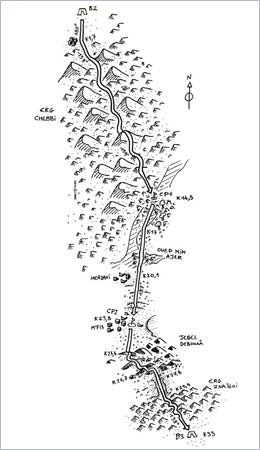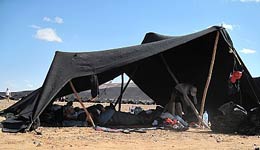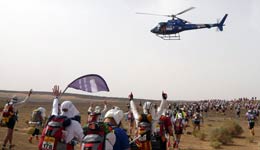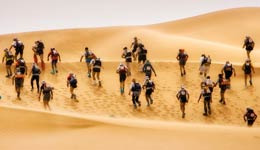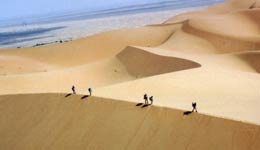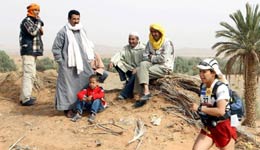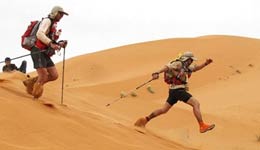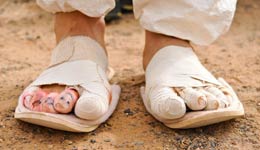6:00 AM – The tent above you had just been taken down, and the rug will literally be pulled out from under you shortly. You have just spent the night in an open sided Berber tent, basically a black tarp stretched over a couple twigs, with 7 other runners. This is when you wonder why ear plugs weren’t on the mandatory equipment list. This is also when you wonder why if you are in one of the hottest places on earth, how can it get close to freezing at night. The tent will be your home for 7 days so you better figure out how to make this work with everyone involved. The aforementioned earplugs and a few sleeping pills help.
The race starts at 9:00 so you turn your focus to preparing for the day: Breakfast, studying the course, prepping your feet and mind for the race.
Breakfast is what you have brought with you. Every meal you eat over the course of 6 days has been brought with you, packed on your back. So meals have been carefully planned down to the gram, calorie, and ml of salt. You have spent agonizing HOURS on a spreadsheet working out the weight of these meals to get the most calories per gram of weight. Hopefully you don’t get sick of the items you have chosen as there are no 7/11’s in the Sahara.
You study the map you have been given of the course. This map seems to have been drawn by a 5 year old child. “Today will be 20 km thru the dunes at a compass reading of 25 degrees – at the palm tree, turn and go 12 km at 47 degrees. Cross over the mountain and by the big rock, turn to 36 degrees. The days finish line is then just 15 km thru another set of dunes and across the dry river bed.”
You try to mentally prepare yourself for the day. To finish this stage, you have to be ready for the many hours of dunes / crossing mountains / 50 degree Celsius heat / salt flats / surviving on rationed water / snakes and scorpions. However the most feared thing in this entire race is the blister. Nothing will stop your chance of finishing this race more than a blister gone bad. You try all the tricks – socks with toes / taping the balls and heels with surgical and duct tape / rubbing your feet with ointments and special potions you’ve found recipes for on the internet. You’ve ordered gaiters from France that are Velcroed to your shoes in hopes of keeping the sand out. Insha’Allah (God willing) these things will help.
9:00 AM: – This should be the start of the race and you are waiting near the start line with most of the other competitors. ACDC’s “Highway to Hell” is blasting from huge speakers nearby. The French are late. The French are always late. Patrick Bauer, the MDS race director makes some important announcements regarding the race; changes to route, warnings, impending sand storms, quick sand, etc… Since this is a French race, and held in Morocco, everything is in French. You patiently wait the 10-15 mins for the French announcements to end and for the English translation to begin. And then you get the English translation – “Good Luck – Go!” – and you think, “did i miss something important?”. Then you’re off. Helicopters and drones [YES! drones] are buzzing overhead as you head off into the desert, capturing all this on film. There are so many cameras in fact, that you feel like extras in some dessert epic – only instead of being paid for your work, you have paid an extraordinary amount to be part of this movie.
You think about the route ahead. The day could be up to approximately 30, 40, 50 or 90 km, depending on the stage. Since this race starts with just over 1000 competitors, you will often be within eyesight of others, so hopefully you will not have to rely much on ythe child drawn map and the “lightest compass you could find” to follow the route. Unless you are a Sand Snake – one of the elite FAST runners out in front – you should be able to just follow the person in front of you. However a few years back, a runner did get lost in a sand storm, and was found 8 days later… in Algeria. So you may want to keep that map and compass handy.
There will usually be three or more check points stationed along the route. These are very important as this is where you receive your water rations. Hopefully you will not require any of the medical access that is here as well. You will get 1.5 litres of water at the start of the day, and then another 1.5 at each checkpoint. For this reason alone, you make sure you follow your map. Throughout the whole day you will only be provided with 9 to 11 litres of water.
You run your stage. How long does it take? Who knows? 6 hours / 10 hours / 30 hours. Hopefully you are running more than you walk. But with the combination of sand dunes, heat, no shade, and lack of food and proper sleep, it will take its toll. Many competitors end up switching from “racing mode” to “surviving mode”. Organizers allow 36 hours to complete the longest 90km stage. An amazing tradition with the MDS is that EVERYONE in camp comes out to cheer on the last competitor to finish this leg. We may all have different running abilities, but we are all in this race together.
You see the finish line and realize you have raced/survived this leg. As you cross the line, you are given your night’s ration of 4.5 litres of water and make your way back to the bivouc. Time to relax? Not a chance! It has been said surviving a desert stage race is 1/3 your ability to run, 1/3 your ability to camp and organize a lean kit/pack/food, and 1/3 your ability to stay healthy [or at least alive].
So now comes the next steps. You immediately have your recovery shake: 320 calories of carbs, proteins, vitamins and electrolytes that keeps your body from cannibalizing itself. You also make sure you hydrate well as running in the windy, 50 degree Sahara has surely dehydrated your body in ways only a convection oven can.
You have been sweating all day, but obviously there are no showers in the Sahara, so you bring with you the next best thing – 5 wetones [these of course have been dehydrated back in Canada – you don’t want the extra weight – so you add a few drops of water to the ziplock bag to get your shower ready].
Similar thing for your sweaty clothes – a quick rinse in minimal water to remove the salt. You don’t worry much about the smell. After day two, everyone in camp has reached maximum stench, and there’s not much you can do, so you just give into it.
You check your feet for blisters and pray the tricks you used this morning have helped. If need be, you care for any little foot issues you can see. At camp, there are huge medical tents that can treat anything from simple blisters to heat stroke and more serious problems. However you do NOT want to go to the Med tent for anything below the ankle. This needs to be treated yourself with the small medical kit you are carrying . The treatment for blisters offered at the medical tents, is often worst than the blister themselves, so basically you want to “just stay away!”
DINNER: You’ve had your recovery shake as soon as you finished the stage, but you still need to consume more calories to help make up for the approx 5,000+ you expended today. Now comes your carefully chosen meal that you spent hours deciding upon and sounded so appealing 3 months earlier. Sand Snakes will pick the lightest/most calorie dense food they can find, so some will try to survive the week on a couple kilos of Macadamia nuts alone [733 calories/100grams]. However after 2 days, the body is quickly tired of this and you will find them begging people to trade for a “Cup a Noodle” [320 cal/100grams]. Your freeze dried Chicken Alfredo in a tinfoil bag [456 cal/100g] is looking down right gourmet right about now so you go about getting your dinner ready. If you are finished early enough in the day, you can just add water to the tinfoil bag and leave it in the Moroccan sun for 10 mins to cook. No need for boiling water. If you don’t finish in time, you have the extra weight of the stove/pot/fuel/etc.. OR you learn to love cold, crunchy food. I’ve chosen to compromise.
- take some fuel so will only use the stove when you really need to [my morning Starbucks?].
- be willing to search for twigs and make myself a real campfire.
- find the lightest stove I can. Mine is 11g but other runners have realized that if you special order a sheet of titanium from Belgium, and use special tools to cut it, fold it a certain way and have it professionally soldered, you can get this down to almost half! 6 grams and save yourself 5 grams… Some people find the 5 grams important [I think my friend Bob did this].
After dinner, you can start to relax. Preparing for the night and all that it brings. Maybe even be able to read a couple nice emails [nudge nudge wink wink]. And oh ya – Note to self – take the sleeping pills!
*** Of course no day in an ultra is typical – and since I haven’t actually run this race yet, these are just things I am preparing for/ looking forward to/ dreading/ from the many race reports I have read. I thought people might be interested knowing it is a bit more than just running up and down sand dunes for a week.


